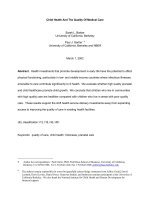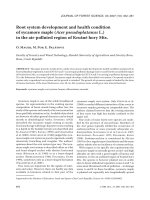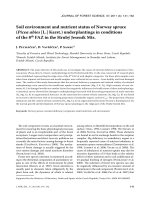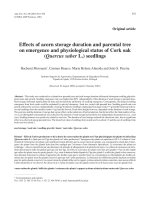Pre-mating, mating and ovipositional duration of gamma irratated uzi fly, a parasitoid of mulberry silkworm Bombyx mori L.
Bạn đang xem bản rút gọn của tài liệu. Xem và tải ngay bản đầy đủ của tài liệu tại đây (236.24 KB, 8 trang )
Int.J.Curr.Microbiol.App.Sci (2019) 8(3): 2490-2497
International Journal of Current Microbiology and Applied Sciences
ISSN: 2319-7706 Volume 8 Number 03 (2019)
Journal homepage:
Original Research Article
/>
Pre-mating, Mating and Ovipositional duration of Gamma Irratated Uzi
Fly, a Parasitoid of Mulberry Silkworm Bombyx mori L.
G. Ashwini* and Fatima Sadatulla
Department of Sericulture, University of Agricultural Sciences,
GKVK, Bengaluru-560065, India
*Corresponding author
ABSTRACT
Keywords
Uzi fly, Silk worm,
Gamma radiation
Article Info
Accepted:
25 February 2019
Available Online:
10 March 2019
The gamma radiation was given to 4 day and 8 day old pupae of uzi flies at two effective
doses of 1.5 and 2 kr and the observations were recorded for two generations and the study
was carried out in the department of Sericulture, UAS, GKVK, Bengaluru. The pre-mating
duration was significantly different between 1.5 and 2 kr when 4 day old pupae and 8 day
old pupae were irradiated, the mating duration was not significantly different between 1.5
and 2 kr when 4 day old pupae and 8 day old pupae were irradiated. The ovipositional
duration showed a significant difference between 1.5 and 2 kr when 4 day old pupae were
irradiated and no significant difference between 1.5 and 2 kr when 8 day old pupae were
irradiated in the first generation. Whereas in the second generation, the pre-mating
duration, mating duration and ovipositional duration did not vary significantly between 1.5
and 2 kr when 4 day old pupae and 8 day old pupae were irradiated.
Introduction
Uzi flies belong to the family Tachinidae of
the order Diptera, are of the most important
among the insect pests, which attack the
silkworm species and causes extensive loss to
the sericulture industry. The application of
synthetic organic pesticides has tremendous
impact on minimizing pest population but
their overuse and frequent misuse and high
sensitivity towards the silkworms, has forced
the entomologists to search for alternatives to
chemical control, which is safe to silkworm
and
environment.
The sterile
insect
technique (SIT) is an autocidal insect control
method whereby numbers of sterile insects
are released into the wild. The sterile males
compete with wild males to mate with the
females. Females that mate with a sterile male
produce no offspring, thus reducing the next
generation's population. Sterile insects are not
self-replicating and, therefore, cannot become
established in the environment.
Materials and Methods
The uzi fly maggots were collected from the
cocoon market, Vijayapura, in plastic boxes
with perforated lid and the uzi maggots were
placed on sand bed in dark condition for
pupation. After emergence, all the adult uzi
flies were provided with 10 per cent glucose
2490
Int.J.Curr.Microbiol.App.Sci (2019) 8(3): 2490-2497
solution in cotton wads kept in the petri plates
as food. The cotton wads dipped in 10 per
cent glucose solution were replaced every day
till the death of the uzi flies. Separation of 4
and 8 day old male uzi pupae (sex separation
was done based on the size and weight of
pupae).The separated male uzi pupae were
irradiated using a 60C source (gamma
radiation), model BI 2000,the facility
available at National Centre for Biological
Sciences
(NCBS),
GKVK
Campus,
Bengaluru. The gamma radiation was given at
two effective doses of 1.5 and 2 kr to the male
pupae. During the irradiation process, the
pupae were kept in plastic containers with lid.
The electronic dose measuring unit attached
to the machine recorded the dosage delivered
to each batch, which was noted down. Three
replications were maintained for each dosage,
with 50 pupae constituting each replication,
along with control for two different aged
pupae of 4 and 8 day old. The irradiated
batches of uzi pupae were confined in
separate rearing cages and utilized to record
the observations.
The data obtained was analyzed using
Factorial CBD. There are two treatments with
two factors i.e., factor 1 is age (4 and 8 day
old irradiated pupae) and factor 2 is radiation
(1.5 kr and 2 kr).
Results and Discussion
Pre-mating duration of male uzi flies
emerged from irradiated pupae
In the first generation, the pre-mating duration
was significantly different between 1.5 and 2
kr (50.70 min and 64.97 min) respectively
when 4 day old pupae were irradiated and
were also significantly different between 1.5
and 2 kr (50.70 min and 64.97 min)
respectively when 8 day old pupae were
irradiated. Whereas in the subsequent
generation the pre-mating duration did not
vary significantly between 1.5 and 2 kr (62.23
min and 52.43 min) respectively when 4 day
old pupae were irradiated and there was no
significant difference between 1.5 and 2 kr
(52.80 min and 63.53 min) respectively when
8 day old pupae were irradiated. There was a
significant difference between the control and
treated batches (Table 1 and Fig. 1). The
Statistical analysis revealed that dose of
radiation was significant and the age of pupae
was non-significant in both the generations.
Similar observations were recorded by
Vasudha (2014) where the pre-mating
duration was 51.36 min and 51.33 min when
4 and 8 day old pupae were irradiated at 1.5
kr respectively and 50.23 min and 51.26 min
when 4 and 8 day old pupae were irradiated at
2 kr respectively. Frank et al., (1984)
recorded the mating competitiveness of
irradiated males mated with normal females
of day 1, 8 and 15 days adults were irradiated
at 0-20 rad. As irradiated males aged, their
progeny’s hatching percentage declined
significantly. Percentage of hatching equaled
46.9% for eggs sired on day 1, and 36.4% on
day 15, a 22% loss was observed.
Mating duration of male uzi flies emerged
from irradiated pupae
In the first generation, the mating duration
was not significantly different between 1.5
and 2 kr (1.61 h and 1.43 h) respectively
when 4 day old pupae were irradiated and no
significant difference between 1.5 and 2 kr
(1.38 h and 1.56 h) respectively when 8 day
old pupae were irradiated. Whereas in the
second generation, the mating duration
showed no significant difference between the
treatment means of 4 and 8 old irradiated
pupae (4.18 h and 3.10 h) respectively and no
significant difference between the treatment
means at 1.5 and 2 kr (3.16 h and 3.49 h)
respectively. There was no variation between
the treated batches and control in both the
generations (Table 2 and Fig. 2). The
2491
Int.J.Curr.Microbiol.App.Sci (2019) 8(3): 2490-2497
Statistical analysis revealed that both dose of
radiation and age of pupae are non-significant
in the first generation whereas in the second
generation, dose of radiation was significant
and age of pupae was non-significant. Similar
findings have been recorded by Frank et al.,
(1984) where the young male moths of
Galleria melonella were exposed to either 0
or 20 rad of ionizing radiation. Treated males
competed with normal males for virgin
females at 1, 8 and 15 days of age. Mating
competitiveness decreased as irradiated males
aged. According to John and Brower (1976)
the mating ability of males with single
females was not significantly affected by
irradiation doses in the Indian meal moth,
Ploida interpunctella which is contradictory
with the present results.
Table.1 Pre-mating duration of male uzi flies emerged from irradiated pupae (first
and second generations)
Radiation
(kr)
Pre-mating
duration (min.)
Mean
Pre-mating
duration(min.)
1st generation
4th day
8th day
1.5
63.60
50.70
2.0
48.70
Control
Mean
Mean
2nd generation
4th day
8th day
57.15a
62.23
52.80
57.51a
64.97
56.83a
52.43
63.53
57.98a
38.57
37.73
38.15b
41.53
43.07
42.30b
50.28
51.13
52.06
53.13
Radiation
Age of pupae
Radiation × Age
of pupae
F-test
*
NS
*
SEm±
3.43
2.80
4.86
CD at 5% level
10.58
8.64
14.97
F-test
*
NS
*
SEm±
2.30
1.88
3.26
CD at 5% level
7.26
5.93
10.27
1st generation
2nd generation
Note:
1. Means followed by the same alphabet are not significantly different.
2. *Significant at 5% level.
3. NS: Non-significant.
2492
Int.J.Curr.Microbiol.App.Sci (2019) 8(3): 2490-2497
Table.2 Mating duration of male uzi flies emerged from irradiated pupae (first and
second generations)
Radiation
(kr)
Mating duration (h)
Mean
Mating duration (h)
1st generation
4th day
8th day
1.5
1.61
1.38
2.0
1.43
Control
Mean
Mean
2nd generation
4th day
8th day
1.49
4.18
3.16
3.67b
1.56
1.49
3.10
3.49
3.29b
1.50
1.53
1.51
4.27
4.59
4.43a
1.51
1.48
3.84
3.74
Radiation
Age of pupae
Radiation × Age of
pupae
F-test
NS
NS
*
SEm±
0.032
CD at 5% level
0.11
0.08
0.16
F-test
*
NS
NS
SEm±
0.20
0.16
0.29
CD at 5% level
0.62
0.50
0.88
1st generation
0.02
0.05
2nd generation
Note:
1. Means followed by the same alphabet are not significantly different.
2. *Significant at 5% level.
3. NS: Non-significant.
2493
Int.J.Curr.Microbiol.App.Sci (2019) 8(3): 2490-2497
Table.3 Ovipositional duration of normal female uzi flies mated with male uzi
flies emerged from irradiated pupae (first and second generations)
Radiation
(kr)
Ovipositional
duration (days)
Mean
Ovipositional
duration (days)
1st generation
4th day
8th day
1.5
3.94
3.16
2.0
3.10
Control
Mean
Mean
2nd generation
4th day
8th day
3.55b
2.43
2.89
2.51b
3.49
3.29b
2.74
2.68
2.71b
4.27
4.59
4.43a
4.30
4.49
4.39a
3.77
3.74
3.05
3.35
Radiation
Age of pupae
Radiation × Age
of pupae
F-test
*
NS
*
SEm±
0.14
0.11
0.21
CD at 5% level
0.46
0.37
0.65
F-test
*
*
NS
SEm±
0.14
0.11
0.20
CD at 5% level
0.43
0.35
0.61
1st generation
2nd generation
Note:
1. Means followed by the same alphabet are not significantly different.
2. *Significant at 5% level.
3. NS: Non-significant.
2494
Int.J.Curr.Microbiol.App.Sci (2019) 8(3): 2490-2497
Fig.1 Pre-mating duration (min.) of male uzi flies emerged from irradiated pupae
(first and second generations)
Fig.2 Mating duration (h) of male uzi flies emerged from irradiated pupae (first and
second generations)
2495
Int.J.Curr.Microbiol.App.Sci (2019) 8(3): 2490-2497
Fig.3 Ovipositional duration (days) of normal female uzi flies mated with male uzi
flies emerged from irradiated pupae (first and second generations
Ovipositional duration of normal female
uzi flies mated with male uzi flies emerged
from irradiated pupae
In the first generation, the ovipositional
duration showed a significant difference
between 1.5 and 2 kr (3.94 days and 3.10
days) respectively when 4 day old pupae were
irradiated and no significant difference
between 1.5 and 2 kr (3.16 days and 3.49
days) respectively when 8 day old pupae were
irradiated. Whereas in the second generation,
the ovipositional duration had no significant
difference between the treatment means of
4and 8 old irradiated pupae (2.43 days and
2.74 days) respectively and there was no
significant difference between the treatment
means at 1.5 and 2 kr (2.89 days and 2.68
days) respectively. The ovipositional duration
was higher in control when compared to
treated batches (Table 3 and Fig. 3). The
statistical analysis revealed that the dose of
2496
radiation was significant and age of pupae
was non-significant in the first generation
whereas, the interaction effect is nonsignificant in the second generation. Similar
results were recorded by Henneberry et al.,
(1963) when untreated males or males
exposed to 8kr showed no difference in
courtship time (27.5 and 28.8 min) during
their first or second matings respectively
either on the same day of treatment or on the
day of treatment. Males exposed to 16 kr were
slower (53.0 and 75.6 min) to mate the first
and second times on the day of treatment.
However, 24 hours after treatment, males
treated with 16 kr had recovered and mated
(30.7 and 32.3 min) as readily as untreated
males.
In conclusion, both the radiation doses (1.5
and 2 kr) induced sterility when male pupae
were irradiated, but there is a difference
between the age of pupae. Younger pupae are
Int.J.Curr.Microbiol.App.Sci (2019) 8(3): 2490-2497
more susceptible to irradiation compared to
older pupae. As the age of pupae advanced
there was an increase in the resistance of the
uzi flies to gamma radiation treatment.
Gamma irradiation induces sterility not only
in the first generation but the radiation effects
have been carried over to the next generation.
References
Frank Eischen, A., Alford Dietz. and John
Brower, H., 1984, Effect of aging on the
mating competitiveness of irradiated
male greater wax moths (Lepidoptera:
Pyralidae). Journal of Economic
Entomology, 77: 1534 - 1536.
Henneberry, T. J. and McGovern, W. L.,
1963, Effects of gamma radiation on
mating competitiveness and behavior of
Drosophila
melanogaster
males.
Journal of Economic Entomology, 56
(6): 739-741.
John,
H. and Brower, 1976, Dose
fractionation: effects on longevity,
mating capacity, and sterility of the
irradiated males of the Indian meal
moth,
Plodia
interpunctella
(Lepidoptera:
Phycitidae).
The
Canadian Entomologist, 108: 823-826.
Knipling E.F., 1955, Possibilities of insect
control or eradication through the use of
sexually sterile males. Journal of
Economic Entomology, 48: 459-462.
Knipling, E.F., 1959, Sterile male method of
population control. Science, 130: 902904.
Narayanaswamy, K. C. and Devaiah, M. C.,
1998, Silkworm uji fly. Zen Publishers,
Bangalore, p. 232.
Vasudha, K., 2014, Induction of male sterility
in silkworm uzi fly, Exorista bombycis
(Louis) – A parasitoid of silkworm,
Bombyx mori L. Ph.D. Thesis, UAS,
Bangalore, p.83-86.
How to cite this article:
Ashwini, G. and Fatima Sadatulla. 2019. Pre-mating, Mating and Ovipositional duration of
Gamma Irratated Uzi Fly, a Parasitoid of Mulberry Silkworm Bombyx mori L..
Int.J.Curr.Microbiol.App.Sci. 8(03): 2490-2497. doi: />
2497









